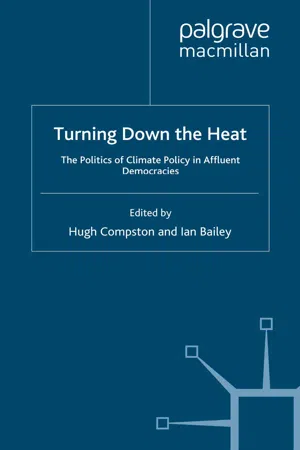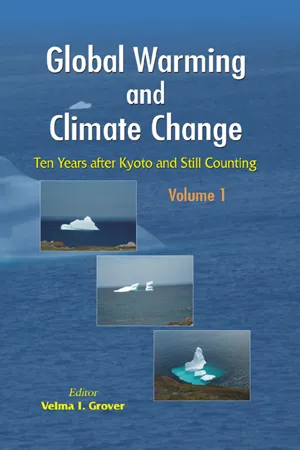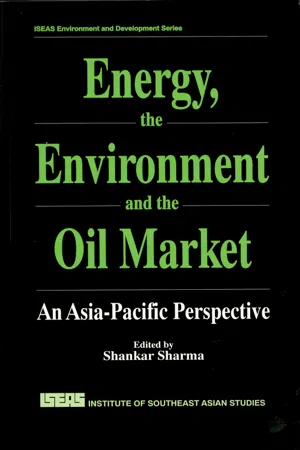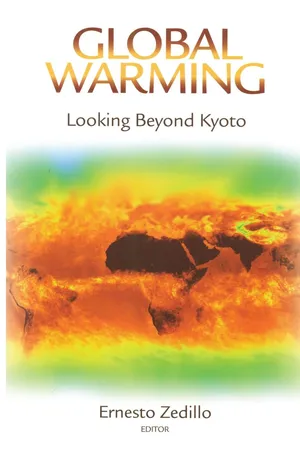Politics & International Relations
Climate Policies
Climate policies refer to the set of measures and actions implemented by governments and international organizations to address climate change. These policies aim to reduce greenhouse gas emissions, promote renewable energy sources, and adapt to the impacts of climate change. They often involve regulations, incentives, and international agreements to mitigate the environmental and social effects of global warming.
Written by Perlego with AI-assistance
Related key terms
1 of 5
8 Key excerpts on "Climate Policies"
- eBook - PDF
Turning Down the Heat
The Politics of Climate Policy in Affluent Democracies
- H. Compston, I. Bailey, H. Compston, I. Bailey(Authors)
- 2008(Publication Date)
- Palgrave Macmillan(Publisher)
44 Political Science Perspectives on Climate Policy the production of regular and thorough environmental impact and strategic environmental assessments that can be used to guide major decisions. Studies of environmental policy integration in the EU nevertheless reveal the difficulties of developing genuine horizontal and vertical policy integration. In particular, demands for national and regional autonomy within the EU have led to unhelpful policy cleavages, while institutional arrangements that gave unequal powers to sectors which historically took little account of their environmental impacts (such as agriculture, energy and transport) have helped to maintain policy fragmentation (Lenschow 2002). Climate policy integration is thus a problem that governments must address to ensure that activities in one branch or level of government to reduce emissions do not undermine other policy goals or climate initiatives developed in other branches or levels. Environmental justice The concept of environmental justice has long been debated by polit- ical science and other social sciences as a basis for understanding and determining policies relating to the distribution of environmental risks throughout society (Dryzek 1997; Schlosberg 1999; Adger et al. 2006). It focuses on the ways in which certain communities, typically low- income residents and ethnic/racial minority groups, disproportionately bear the environmental costs of industrial activities and, increasingly, climate change. A path-breaking 1987 study, updated in 1994, for exam- ple, found that, in the USA, race was the most significant variable in explaining the location of commercial hazardous waste facilities (Charles 1987; Goldman and Fitton 1994). Climate change raises particularly challenging ethical issues about distributive justice because of the mismatch between those who enjoy the benefits of emissions and those who bear the burdens but lack the resources to adapt to or evade them. - eBook - PDF
Brazil and Climate Change
Beyond the Amazon
- Viola Eduardo, Matías Franchini(Authors)
- 2017(Publication Date)
- Routledge(Publisher)
18 Climate change and international relations However, these analytical approaches, in our view, are incomplete because they focus on only one aspect of the role of states in the political economy of climate change: either domestic policy, foreign policy, or emissions trajectory. There are two exceptions, the Climate Performance Index of Burck, Marten, and Bals (2014) and the Cooperation within the Regime work of Bättig, Brander, and Imboden (2008), but these also have speci fi c problems. In the fi rst case, Burck, Marten, and Bals (2014) give excessive weight to the emissions path (80%), and they rely on specialists ’ opinions to evaluate the path of climate poli-cies, and not on objective criteria, as we do. As for Bättig, Brander, and Imboden (2008), they only focus on international policies — whether countries had rati fi ed the UNFCCC and the Kyoto Protocol, and whether countries had made fi nan-cial contributions to the UNFCCC — and the path of the carbon intensity of per capita GDP. They do not consider the domestic policy realm and the per capita level of emissions, which are both crucial to understanding countries ’ position in the political economy of climate change. Our approach, on the other hand, aggregates both the political dimension (foreign and domestic climate policy) and the GHG emissions pro fi le dimension. In doing so, we avoid the problems of reductionism present in the other propo-sals. From one side, the trajectory of emissions is the decisive issue to measure the dynamic of a country in the global carbon cycle and how much better or worse it is behaving in relation to the whole. However, that trend can be altered by political measures, even when it could be a timing gap between the willingness of a country to decarbonize and the trajectory of emissions, because in many situa-tions the new policies take time to have a signi fi cant e ff ect on emissions trajec-tory. - eBook - ePub
The Politics of Climate Change
Environmental Dynamics in International Affairs
- Paul G. Harris(Author)
- 2013(Publication Date)
- Routledge(Publisher)
3–14 Haigh, Nigel (1996) ‘Climate change policies and politics in the European Community’ in Timothy O’Riordan and Jill Jäger (eds) Politics of climate change: a European perspective (New York: Routledge), 155–185 Harris, Paul (ed) (2007) Europe and global climate change: politics, foreign policy and regional cooperation (Cheltenham, United Kingdom: Edward Elgar) Héritier, Adrienne (1996) ‘The accommodation of diversity in European policymaking and its outcomes: regulatory policy as a patchwork’, Journal of European Public Policy, 3:2, 149–167 Héritier, Adrienne (1999) Policy-making and diversity in Europe: escape from deadlock (Cambridge: Cambridge University Press) Héritier, Adrienne, Christoph Knill and Susanne Mingers (1996) Ringing the changes in Europe: regulatory competition and redefinition of the state - eBook - PDF
Global Warming and Climate Change (2 Vols.)
Ten Years after Kyoto and Still Counting
- V I Grover(Author)
- 2016(Publication Date)
- CRC Press(Publisher)
Climate Change Policy in North America and the European Union Paul Hamilton Department of Political Science, Brock University St. Catharines, Ontario, Canada L2S-3A1 E-mail: [email protected] INTRODUCTION Almost ten years after the Kyoto Protocol was signed it seems appropriate to review the development of climate change policy in the European Union, Canada and the United States. All three are fragmented polities, with federal or quasi-federal arrangements. Together, the three jurisdictions contribute the largest share – two-thirds—of greenhouse gases (GHG) produced annually and each has had its own challenges in developing a coherent and politically palatable response to the challenges of global warming (Tanzler and Carius 2004). Comparative political science seeks to explain similarities and differences among and between political units of analysis. These may be political parties, judiciaries, or states as a whole. One might consider public policy and its variations. Some jurisdictions ban cigarette smoking, while others leave such decisions to the private sphere. Differences in public policy have numerous explanations: national characters, political culture, political institutions, and international contexts all have supporters in the academic community. Global environmental policy is particularly challenging for comparativists. In addition to the usual 24 CHAPTER 564 Global Warming and Climate Change explanatory variables for policy outcomes, we now can add international factors, such as international law as found in treaties and the coercive pressure of world public opinion. In this chapter, the point of view that the primary determinant of state policy regarding GHG emissions is internal institutional structure. Also that it is simplistic to see the climate change policy as the exclusive domain of sovereign states, and that substate jurisdictions are increasingly determined to respond to the challenge of global warming. - eBook - PDF
- Matthew Paterson(Author)
- 2021(Publication Date)
- Cambridge University Press(Publisher)
2.2.1 Conceptualizing Politics Politics can be understood in three distinct ways, all of which express something that we mean when we use the term in everyday speech, which political science as an academic discipline has tried to express more precisely. 2 First is to think about politics as the site(s) of collective authoritative decision- making. This is what is usually contained in the commonplace conflation of politics with parliament, legislation, government, and in the abstraction of this focus in much of contemporary political science via the concept of ‘the State’. It is what Leftwich (2004) refers to when he discusses thinking about politics as an ‘arena’. But even when we focus, as lots of recent research on climate politics does, on novel arenas for climate change – transnational, multilevel, non-state, public–private hybrids, and so on – what is political about climate is that it entails collective decisions that make rules that bind us, distribute authority and resources, and decide between competing options, interests, and values. To be interested in 2 I am certainly condensing here more than many might feel comfortable with. Colin Hay (2002, 61–62) gives twelve definitions in regular use, for example, although I think many of those collapse into the three I give here. There is one in particular that I leave out here but which is present in some existing work on climate politics. This is where politics is explicitly conceptualized as a question of strategic intervention towards the pursuit of emancipation. Mann and Wainwright (2018) for example think about climate politics mostly this way, as do from various perspectives Connolly (2017), MacGregor (2014), and Wall (2020), although they also at times articulate it as a set of arenas or power struggles. 2.2 Thinking Politically about Climate Change 19 climate politics is thus to be interested in the dynamics involved in and between these sites. - eBook - PDF
Energy, the Environment and the Oil Market
An Asia-Pacific Perspective
- Shankar Sharma(Author)
- 2018(Publication Date)
- ISEAS Publishing(Publisher)
Such payments could be made both for policies that directly reduce greenhouse gas emissions and for poli-cies that help countries adapt to new climates. Other countries that could benefit from new climates actually might be willing to pay to bring the new climates about . Despite the current lack of such information, public concern over the possibility of global warming and its potential irreversibility is so high that world policy-makers completed international negotiations on a climate change framework convention. This treaty was negoti-ated through the United Nations International Negotiating Committee (INC), and signed in June 1992 at the United Nations Conference on Environment and Development, held in Rio De Janeiro. The treaty is expected to be ratified and come into force by 1994. Global Climate Change Policy 79 This treaty provides a framework for long term international co-operation to deal with the climate change issue. While some coun-tries sought to limit world carbon dioxide and other greenhouse gas emissions to 1990 levels by the year 2000, the treaty does not impose such requirements. None the less, a number of countries continue to support this policy approach. Thus the outcome of this treaty pro-foundly could affect all of the peoples of the world, depending on the specific commitments ultimately made to reduce greenhouse gas emissions. Reducing greenhouse gas emissions is not without cost. In gen-eral, the larger the required reductions, the higher the cost to achieve them, and the greater the negative effect on world economies. And even if treaty implementation should be delayed and individual coun-tries impose major greenhouse gas emission reductions within their own borders, their decisions, through economic linkages, could dras-tically affect the economic well-being of their trading partners. These issues, which will be discussed in the following pages, have particular importance for the developing Asia-Pacific region. - Ömer Ugur, Kadir Caner Dogan(Authors)
- 2019(Publication Date)
- Peter Lang Group(Publisher)
As distinct from other international subjects, building of international cli- mate regime is carried out by means of multilateral negotiations comprising all the actors. Inasmuch as reconciliation of reciprocal independence of sovereign states and interdependence of environment inevitably necessitates international organization and nongovernmental groups to act in unison alongside the states. And this situation led international organizations and nongovernmental groups to be regarded as actors in international relations as well as traditional actors. Acceptance of these new groups as actors both accelerated the building of the regime and also enabled them to play significant roles in application of the decisions taken and in increase of its efficiency. 4 Policy Choices and Governance Dilemma As stated above, international climate regime and governance constitute a struc- ture including making hard choices between alternatives supported by different actor groups. Although climate change is certainly a complicated problem, it is observed that establishing a policy at an international level particularly under the effect of lack of scientific knowledge is even more complicated (Giddens, 2013: 35). Not being able to present a scientific certainty regarding climate change issues makes it easier for political actors to act in accordance with their political interests within decision-making processes and causes states to race their own preferences within this process (Kutting, 2000: 63). Besides, climate governance necessitates negotiation of many political preferences at the table with regards to participation of actors from various levels, its comprehensiveness and binding obligations. However, it is not always possible to reconcile the interests and pri- orities of states, which have different economic, social and political structures from each other, and other actors and convince them to cooperate at an inter- national level.- eBook - PDF
Global Warming
Looking Beyond Kyoto
- Ernesto Zedillo(Author)
- 2008(Publication Date)
- Brookings Institution Press(Publisher)
climate change: designing an effective response 137 —For regimes with a larger number of members, nonmandatory processes and mechanisms are more effective in setting and encouraging ambitious behav-ior targets than are regimes under which compliance is mandatory. —Compliance is not equal to effectiveness. —Climate change is a derivative problem of sectors that are already politi-cally regulated. —Policy in politically regulated sectors will be decided by agents with orga-nizationally constrained priorities, which must be taken seriously and which must be framed in ways familiar to these established organizational cultures. —The political priorities of empowered actors in these regulated sectors are nowhere, especially in developing countries, focused on climate. —Environmental constraints on emitting sectors will be resisted by sectoral authorities unless these constraints advance the authorities’ higher priority goals. —In politically regulated sectors, shifting the institutional context for mar-ket behavior over time is more sustainable than imposing new forms of current regulation. —All politically regulated sectors can and will be gamed. —A price signal high enough to give appropriate signals for both short- and long-term aspects of the climate problem is not politically feasible in the absence of deep external shock. Three Dimensions (of a post-Kyoto Architecture) The post-Kyoto architecture can be seen in three dimensions: the actors, the problems, and the pillars. Because climate change is overwhelmingly associated with emissions from energy, transport, and land use, sectors essential to growth and development that are not yet characterized by technological breakthroughs that allow substi-tution at large scale of nonemitting sources at costs comparable to fossil fuels, policy choices in these sectors that determine development paths are made by politically empowered actors, mostly in line ministries, dedicated agencies, and finance ministries.
Index pages curate the most relevant extracts from our library of academic textbooks. They’ve been created using an in-house natural language model (NLM), each adding context and meaning to key research topics.







